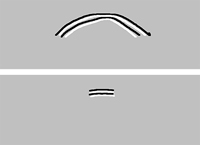SAFT
Synthetic Aperture Focusing Technique
SAFT – Synthetic Aperture Focusing Technique – is a signal processing technique which takes advantage of the movement of a small conventional transducer to simulate, in effect, a phased array that is extremely long. This allows high resolution at long range, with relatively small transducers. SAFT processing is applied in RADAR and SONAR as well as ultrasonics. SAFT in ultrasonics has been around for over twenty years but the amount of processing required has meant that it has had to wait for developments in computing technology before it can be readily applied. Unfortunately, phased arrays have developed at the same time so the requirement for SAFT has decreased.
 SAFT takes into account the beam spread of a transducer and by combining A-scans from adjacent transducer positions according to the SAFT algorithm produces a focused response. One technique where SAFT processing is particularly useful is in the TOFD technique. Conventional TOFD uses small transducers which have a wide beam spread which in turn produces large arcs from defects on the TOFD display as shown in the top of the Figure. By applying a SAFT algorithm the origin of these responses is narrowed down to a more precise position as shown in the bottom Figure.
SAFT takes into account the beam spread of a transducer and by combining A-scans from adjacent transducer positions according to the SAFT algorithm produces a focused response. One technique where SAFT processing is particularly useful is in the TOFD technique. Conventional TOFD uses small transducers which have a wide beam spread which in turn produces large arcs from defects on the TOFD display as shown in the top of the Figure. By applying a SAFT algorithm the origin of these responses is narrowed down to a more precise position as shown in the bottom Figure.
For more information on SAFT see:
'SAFT – Is it a Tool for Improved Sizing in Ultrasonic Testing?', J Pitkanen, ECNDT 2006 – Poster 211 at www.ndt.net/article/ecndt2006/doc/P211.pdf
What the hec?! articles are not intended to be the definitive account on the topic or acronym in question. Readers’ comments and contributions are welcomed. Email: ndtnews@bindt.org
 SAFT takes into account the beam spread of a transducer and by combining A-scans from adjacent transducer positions according to the SAFT algorithm produces a focused response. One technique where SAFT processing is particularly useful is in the TOFD technique. Conventional TOFD uses small transducers which have a wide beam spread which in turn produces large arcs from defects on the TOFD display as shown in the top of the Figure. By applying a SAFT algorithm the origin of these responses is narrowed down to a more precise position as shown in the bottom Figure.
SAFT takes into account the beam spread of a transducer and by combining A-scans from adjacent transducer positions according to the SAFT algorithm produces a focused response. One technique where SAFT processing is particularly useful is in the TOFD technique. Conventional TOFD uses small transducers which have a wide beam spread which in turn produces large arcs from defects on the TOFD display as shown in the top of the Figure. By applying a SAFT algorithm the origin of these responses is narrowed down to a more precise position as shown in the bottom Figure.For more information on SAFT see:
'SAFT – Is it a Tool for Improved Sizing in Ultrasonic Testing?', J Pitkanen, ECNDT 2006 – Poster 211 at www.ndt.net/article/ecndt2006/doc/P211.pdf
What the hec?! articles are not intended to be the definitive account on the topic or acronym in question. Readers’ comments and contributions are welcomed. Email: ndtnews@bindt.org